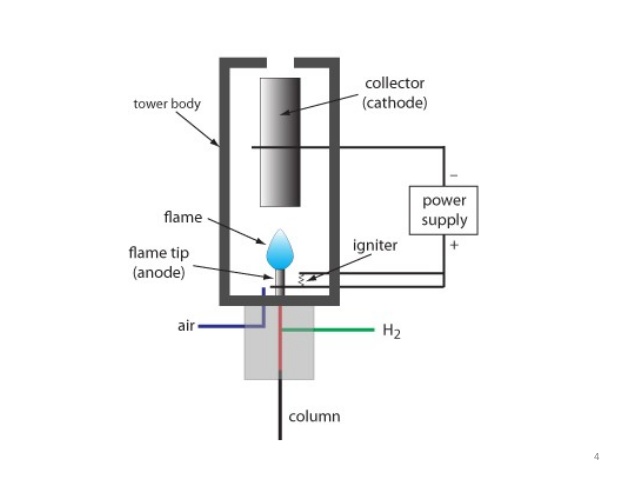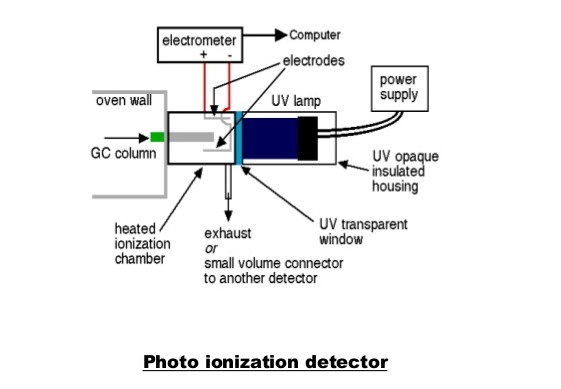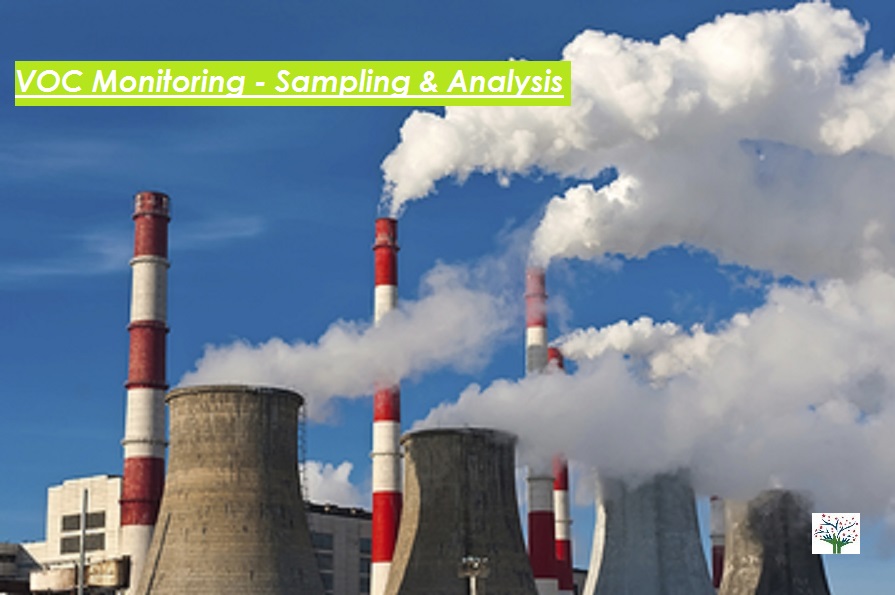Volatile Organic Compounds (VOCs) Monitoring & Testing
What are Volatile Organic Compounds (VOC)?
VOCs are gases that are emitted by certain liquids and solids. VOCs are bad for health, some have short term while others have long lasting ill-effects. To make matters worse, VOC concentration are 10 times higher indoors than outdoors and several products that are easily available in the market emit this harmful compound. VOC monitoring is the process of testing volatile Organic Compounds in environment.
Ingredients required to make household products like paints, wax and varnishes contain VOCs, also cosmetic, disinfecting and cleaning products are found laced with VOCs. All of these products emit harmful gases while using or storing them. A study conducted by Total Exposure Assessment Methodology (TEAM) found the levels of organic pollutants significantly higher indoors, and it didn’t matter whether the house was located in rural or highly industrial areas.
Read more about Importance of Air Quality Monitoring
A hazardous observation is that the organic pollutants emitted by these household products can persist in the air long after the activity is concluded.
Primary sources of VOCs
Several household products emit organic pollutants, some of them are –
- Dry-cleaned clothing
- Wood preservatives
- Hobby supplies
- Aerosol sprays
- Pesticides
- Paints and other solvents
- Automotive products
- Cleansers
- Stored fuels
- Disinfectants
- Glues and adhesives
- Furnishings and building materials
- Printers and copiers
- Permanent markers
Health Effects of VOC (Volatile Organic Compounds)
As you can see, mostof the products are utilized by us on a daily basis and we have no knowledge its adverse effects on our health. VOCs can cause several conditions that are detrimental to one’s health, some of they are –
- Cancer in humans and animals
- Severe headaches and nausea
- Injury of the central nervous system, liver and kidney
- Nose, eyes and throat irritation
These were the health effects, following are some signs and symptoms to look out for –
- Dizziness
- Headache
- Fatigue
- Conjunctival irritation
- Emesis
- Allergic skin reaction
- Epistaxis
- Dyspnea
- Throat and nose uneasiness
- Gradual decline in serum cholinesterase levels
Health effects caused by organic chemicals are mainly dependent on its toxicity level and the amount of time the person has been exposed to VOCs. Some immediate symptoms to high levels of exposure include –
- Dizziness
- Respiratory tract and eye uneasiness
- Memory impairment
- Visual disorder
- Headaches

Learn More about Stack Emission monitoring
Nowadays, VOC Monitoring can detect level of fatigue in humans and some project can even detect cancer in liver.#vocmonitoring pic.twitter.com/8RbMAayGXf
— Perfect Pollucon Services – Air Quality Monitoring (@PerfectPollucon) August 7, 2022
Volatile Organic Compounds (VOCs) Testing Methods
There are 2 widely used methods to VOC Monitoring or testing.
These technologies are –
- Flame Ionization Detection
- Photo Ionization Detection

Flame Ionization Detectors (FIDs) – FIDs use a hydrogen flame to ionize the VOC. The FIDs can be burdensome to move around the designated work area as it requires a hydrogen cylinder to provide gas. In order not to receive inaccurate readings, a heated sample line should be used when extracting VOCs from the exhaust shaft, this will prevent the VOCs from condensing and giving you an accurate result.

Photo Ionization Detectors (PIDs) – The working of the PIDs and the FIDs are the same, except the former uses ultra-violet light to ionize VOCs. Another important aspect of PIDs are that they eliminate Methane while measuring VOCs, this ensures that any background levels of methane in the atmosphere can be neglected in the final reading.
Monitoring of VOC levels are imperative as if left unchecked, prolong exposure can cause damage of several internal organs and low level exposure can cause severe problems in the long run. VOC monitoring & Testing can be done using specific designed instruments, they come in different sizes, these instruments are portable or can be fixed and is apt to monitor the organic pollutant levels in your home or/and office space.
Volatile Organic Compounds (VOCs) Testing Lab Report
A VOC testing lab report provides a detailed analysis of the presence and concentration of volatile organic compounds in a given environment. These reports typically include sampling data, analytical methods used (e.g., GC-MS or PID), comparison with regulatory standards, and recommendations for mitigation if VOC levels exceed permissible limits.
VOC Test Report
A VOC test report provides a breakdown of detected compounds, their concentration levels, comparison against regulatory limits, and recommendations for remediation. It serves as official documentation for regulatory compliance in industries and workplaces.
Volatile Organic Compounds (VOCs) Testing Equipment
Different types of VOC testing equipment are used based on the method of detection. These include:
- Gas chromatography-mass spectrometry (GC-MS) – Highly accurate lab-based analysis
- Photoionization detectors (PIDs) – Real-time detection of VOCs
- Flame ionization detectors (FIDs) – Used for high-concentration VOC monitoring
- Fourier-transform infrared (FTIR) spectrometers – Detects VOCs through infrared absorption
The choice of equipment depends on the required sensitivity, portability, and application (indoor, industrial, or environmental monitoring).
VOC Analysis Methods
VOC analysis methods include qualitative and quantitative approaches for measuring VOCs in air samples. The most commonly used techniques are:
- Gas Chromatography (GC-MS) – Identifies and quantifies VOCs with high precision
- Photoionization Detection (PID) – Measures total VOC concentration in real time
- Flame Ionization Detection (FID) – Detects hydrocarbon-based VOCs
- Infrared Spectroscopy (FTIR) – Identifies functional groups in VOC molecules
Selecting the right analysis method depends on regulatory requirements and the complexity of the sample matrix.
Continuous VOC Monitoring
Any type of Gas detection systems play very important role in safety of employees at chemical plants, laboratories and ETPs. Since it takes no time to deteriorate the environmental and human health once it is exposed to VOC, hence it is very important to know in case of leakage or accidents at real time to save lives.
VOC Test Standard
VOC test standards vary across regions and industries. Common standards include:
- EPA TO-15 (for air canister sampling)
- ASTM D6196 (for VOCs in ambient air)
- ISO 16000-6 (for indoor VOC measurement)
- OSHA methods (for workplace exposure limits)
These standards ensure that VOC monitoring is accurate and compliant with environmental regulations.
VOC Sensor Working Principle
Some of them are capable enough to accurately measure event smallest quantities of VOC present in ambient air at ppb level.
Most of the Continuous VOC monitoring devices available in market are using photoionisation detection (PID) technology to measure concentration of various VOC compounds like Benzene, etc. This PID technology allows sensors to detect VOC even at low concentrations.
In short, PID detector had ultraviolet lamp which emits photons. When the compound absorbs the Photons released by lamp it makes electrons to leave and creates positive ions. Ions are collected on electrodes and current generated by it gives the measure of the compound. benefits of PID technology is cost effective, easy to use, real time measurement and can detect very low concentrations as well.
Read more about Air quality monitoring for home or office
How to reduce the exposure of VOCs
- Increase the ventilation
- Don’t store any opened containers of unused paints
- Always follow the manufacturer’s directions while using a household product
- Pest management techniques to curb the need of pesticides
- Don’t purchase excess of material, buy only in limited quantities
- Keep the products away from children and pets
- Never mix household products unless instructed to on the label
- Follow the instructions specified on the label carefully
Also read How to reduce air pollution from industries
If you adhere to the above mentioned pointers then the chances of exposure to VOCs are extremely low. VOCs are bad for you, your children and your pets, it’s reported that immediately after certain activities such as paint stripping, organic pollutants shoot up to a thousand times than the background levels. Imagine the amount of damage these toxic levels of VOCs can do to your body, it’s paramount that you monitor and measure the levels of organic pollutants either by using the detectors or by hiring professional services. Trained professionals know the exact methods of VOC monitoring & Testing and will ensure that they are under control in your home or/and office space.
Perfect Pollucon Services Offers Services in Volatile Organic Compounds Testing and Monitoring for homes and offices.
Volatile Organic Compounds (VOCs) Testing or Monitoring
- Implement a organized solvent management program to reduce VOC emissions
- Identify and reduce leakages of VOCs in company
- Determine continual improvement in environmental performance of your company
- Fulfil health, safety and environmental requirements as per government’s notifications
- Optimize process flows to improve efficiency and profitability
VOC Testing Company
Perfect Pollucon Services is known as an expert in VOC Testing for homes and offices. Contact our experts now if you want to check VOC levels for your home of office.
Volatile Organic Compounds (VOCs) Testing Near Me
If you are looking for VOC testing near you, many environmental consulting firms and certified laboratories provide on-site air quality assessments. These services use specialized equipment to measure VOC levels in homes, offices, and industrial settings, ensuring compliance with health and environmental regulations.
VOC Monitors can detect small changes in specific gases and send the data to the central monitoring system. Also, some companies periodically check VOC using portable machines to monitor VOC Levels on premises.
Volatile Organic Compounds (VOC) are various harmful chemicals that are found in many products used in building and maintaining things around us. They are emitted into the air we breathe in a process known as ‘Off-gassing’.
To Monitor VOC, there are mainly 3 types of methods i.e. Continuous, Discontinuous or on-site. The other techniques include flame ionisation detectors (FIDs), catalytic oxidation, and infra-red techniques (IR) such as infrared spectroscopy.
Volatile organic compound-compliant (VOC Compliance), refers to a system, substance or application that follows government regulations regarding volatile organic compounds. In India, as per NAAQS, only Benzene (C6H6) has been defined since November 2009.
There are three distinct groups of Volatile Organic Compounds (VOCs). These differences are based on the boiling point of each chemical. They include VVOCs (Very Volatile Organic Compounds), VOCs (Volatile Organic Compounds) and SVOCs (Semi-Volatile Organic Compounds). Some chemicals, for example, Formaldehyde & Acetaldehyde more accurately fit within the VVOC grouping, whilst chemicals including Benzene, Toluene and Xylenes fit more accurately within the VOC grouping.
You can get rid of VOCs and let some fresh air into your home by opening a window and doors, using the exhaust fan in your kitchen or bathroom, or having a mechanical ventilator installed and maintained regularly. Heat or energy recovery ventilators remove stale indoor air and pull the same amount of fresh air into your home. This way it decreases the amount of VOC you breathe over time.
As per most of the guidelines a concentration of less than 0.5 mg/m3
VOCs can be tested using sorbent tubes, real-time sensors, or gas chromatography-mass spectrometry (GC-MS) to detect and quantify their presence in the air.
VOC testing follows standards like EPA Method TO-15, ASTM D6196, and ISO 16000-6, which outline sampling and analysis procedures for air quality assessment.
VOC detection utilizes devices such as photoionization detectors (PIDs), flame ionization detectors (FIDs), and gas chromatographs with mass spectrometry (GC-MS).
Key parameters include total VOC concentration (TVOC), specific compound identification, permissible exposure limits, and air sampling duration.
Instruments like PIDs, FIDs, Fourier-transform infrared (FTIR) spectrometers, and GC-MS analyzers are commonly used for VOC measurement.
VOC testing is conducted by environmental consultants, industrial hygienists, regulatory agencies, and certified laboratories.
Safe VOC levels vary by guideline, but WHO recommends indoor TVOC levels below 0.3 mg/m³ for long-term exposure.
ASTM standards such as ASTM D5116 and ASTM D6196 define VOC sampling, analytical techniques, and emission rate calculations.
Common VOCs include benzene, formaldehyde, toluene, and xylene, often found in paints, solvents, and household products.
Portable VOC meters, continuous monitoring stations, and laboratory-grade GC-MS are used for VOC measurement.
VOC testing methods include canister sampling (TO-15), sorbent tube sampling (TO-17), and direct-reading instruments like PID meters.
Standards like ISO 16000, EPA TO-15, and OSHA methods define best practices for VOC monitoring in various environments.
VOC standards vary globally, with EPA, OSHA, WHO, and ISO providing permissible exposure limits and testing protocols.
VOCs are tested through active or passive air sampling, direct sensor measurement, or laboratory analysis of collected samples.



Since concentrations are dynamic, traditional assessment methods can yield flawed results (see: http://onlinelibrary.wiley.com/doi/10.1111/gwmr.12140/abstract). As such, we’ve developed an automated continuous monitoring and response platform that can rapidly determine the spatial and temporal nature of VOC releases/exposures and automatically trigger alerts such as email blasts and even engagement of engineering controls. This service is cost-competitive with traditional sampling and analytical services, but with far greater accuracy and response capabilities. For instance, responses occur before a risk duration of concern has transpired, whereas traditional approaches often require weeks or longer before a result is derived. By that time receptors have been unnecessarily exposed. For more information, please visit: http://www.groundswelltech.com/VaporSafe.aspx.